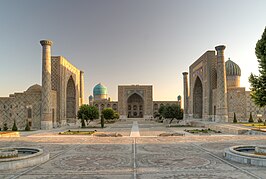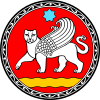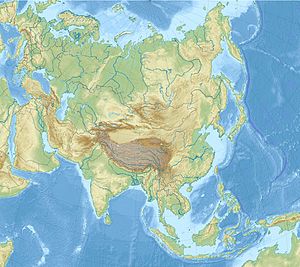
Back Samarkand ACE Samarkand Afrikaans ሳማርቃንድ Amharic Sarmagant AN سمرقند Arabic سمرقند ARZ Samarcanda AST Самаркъанд AV Səmərqənd Azerbaijani سمرقند AZB
Samarkand
Самарканд | |
|---|---|
City | |
Clockwise from the top: Registan square, Shah-i-Zinda necropolis, Bibi-Khanym Mosque, view inside Shah-i-Zinda, Sher-Dor Madrasah in Registan, Timur's Mausoleum Gur-e-Amir. | |
| Coordinates: 39°39′17″N 66°58′33″E / 39.65472°N 66.97583°E | |
| Country | |
| Vilayat | Samarqand Vilayat |
| Settled | 8th century BCE |
| Government | |
| • Type | City Administration |
| • Body | Hakim (Mayor) |
| Area | |
| • City | 120 km2 (50 sq mi) |
| Elevation | 705 m (2,313 ft) |
| Population (1 January 2019) | |
| • City | 513,572[1] |
| • Metro | 950,000 |
| Demonym | Samarqandian / Samarqandi |
| Time zone | UTC+5 |
| Postal code | 140100 |
| Website | samarkand.uz |
| Official name | Samarqand – Crossroads of Cultures |
| Criteria | Cultural: i, ii, iv |
| Reference | 603 |
| Inscription | 2001 (25th Session) |
| Area | 1,123 ha |
| Buffer zone | 1,369 ha |
Samarkand or Samarqand (/ˈsæmərkænd/ SAM-ər-kand; Uzbek and Tajik: Самарқанд, pronounced [sæmærqænd, -ænt]; Persian: سمرقند) is a city in southeastern Uzbekistan and among the oldest continuously inhabited cities in Central Asia. Samarqand is the capital of Samarqand Region and a district-level city, that includes the urban-type settlements Kimyogarlar, Farhod and Khishrav.[2] With 551,700 inhabitants (2021),[3] it is the third-largest city of Uzbekistan.
There is evidence of human activity in the area of the city dating from the late Paleolithic Era. Though there is no direct evidence of when Samarqand was founded, several theories propose that it was founded between the 8th and 7th centuries BCE. Prospering from its location on the Silk Road between China, Persia and Europe, at times Samarqand was one of the largest[4] cities in Central Asia,[5] and was an important city of the empires of Greater Iran.[6] By the time of the Persian Achaemenid Empire, it was the capital of the Sogdian satrapy. The city was conquered by Alexander the Great in 329 BCE, when it was known as Markanda, which was rendered in Greek as Μαράκανδα.[7] The city was ruled by a succession of Iranian and Turkic rulers until it was conquered by the Mongols under Genghis Khan in 1220.
The city is noted as a centre of Islamic scholarly study and the birthplace of the Timurid Renaissance. In the 14th century, Timur made it the capital of his empire and the site of his mausoleum, the Gur-e Amir. The Bibi-Khanym Mosque, rebuilt during the Soviet era, remains one of the city's most notable landmarks. Samarqand's Registan square was the city's ancient centre and is bounded by three monumental religious buildings. The city has carefully preserved the traditions of ancient crafts: embroidery, goldwork, silk weaving, copper engraving, ceramics, wood carving, and wood painting.[8] In 2001, UNESCO added the city to its World Heritage List as Samarqand – Crossroads of Cultures.
Modern Samarqand is divided into two parts: the old city, and the new city, which was developed during the days of the Russian Empire and Soviet Union. The old city includes historical monuments, shops, and old private houses; the new city includes administrative buildings along with cultural centres and educational institutions.[9] On September 15–16, 2022, the city hosted the 2022 SCO summit.
Samarkand has a rich multicultural and plurilingual history that was significantly modified by the process of national delimitation in Central Asia. Many inhabitants of the city are native or bilingual speakers of the Tajik language,[10][11] whereas Uzbek is the official language and Russian is also widely used in the public sphere, as per Uzbekistan's language policy.
- ^ "The State Committee of the Republic of Uzbekistan on Statistics". Archived from the original on 2020-04-29. Retrieved 2020-04-26.
- ^ "Classification system of territorial units of the Republic of Uzbekistan" (in Uzbek and Russian). The State Committee of the Republic of Uzbekistan on statistics. July 2020.
- ^ "Urban and rural population by district" (in Uzbek). Samarkand regional department of statistics. Archived from the original (PDF) on 2022-02-13.
- ^ Varadarajan, Tunku (24 October 2009). "Metropolitan Glory". The Wall Street Journal.
- ^ Guidebook of history of Samarqand", ISBN 978-9943-01-139-7
- ^ NikTalab, Poopak (2019). From the Alleyways of Samarqand to the Mediterranean Coast (The Evolution of the World of Child and Adolescent Literature). Tehran, Iran: Faradid publishing. pp. 18–27. ISBN 9786226606622.
- ^ "History of Samarkand". Sezamtravel. Archived from the original on 3 November 2013. Retrieved 1 November 2013.
- ^ Энциклопедия туризма Кирилла и Мефодия. 2008.
- ^ "History of Samarkand". www.advantour.com. Archived from the original on 2018-05-16. Retrieved 2018-05-15.
- ^ "The Persian-speaking cities of Bukhara and Samarqand, rightly considered by today’s Tajiks as the constituting the historical centres of Tajik civilization" Foltz, Richard. A History of the Tajiks: Iranians of the East. I.B. Tauris, 2019. p.9
- ^ D.I. Kertzer/D. Arel, Census and identity Archived 2022-11-17 at the Wayback Machine, Cambridge University Press, 2001, pp. 186–188.
© MMXXIII Rich X Search. We shall prevail. All rights reserved. Rich X Search









